Retro: Apple Powerbook 3400c / 200 1997
On February 17, 1997, a press release of the new Apple line of notebooks, the Powerbook 3400, was held. This series was released in three versions, differing mainly in the processor frequency (180, 200 and 240 MHz). At that time, the laptop was announced as “the fastest laptop in the world.”

')
It was the first powerbook based on the Intel PCI architecture. This series of laptops was equipped with an active matrix.
In our museum was the average model line.
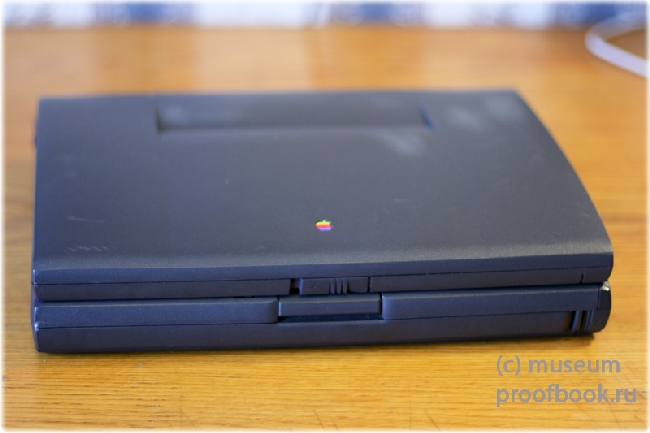
It is equipped with a 200 MHz PowerPC 603e processor, a 12.1 ″ display with a resolution of 800 × 600 pixels, 80 megabytes of RAM and a 2 GB 2.5 ”hard disk with an ide interface.
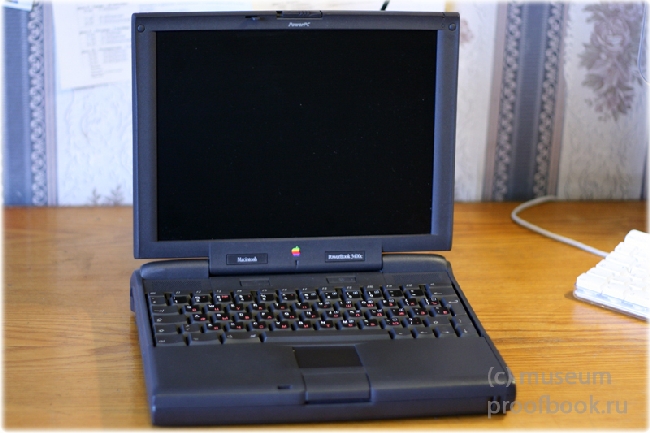
Consider it from all sides.
On the left are the audio connectors (microphone and headphones), two pcmcia slots, ADB-connector.
It should be immediately noted one feature: the extraction of pcmcia-cards is a little non-standard way. After pressing the button to the left of the corresponding slot, the mechanism “spits out” the card (the mechanical method is more usual, using pressure on the lever). In the off state or in sleep mode, pcmcia cards cannot be removed. For emergency cases, there is a hole next to each port, using a unfolded clip you can remove the card (just like in cd-drives).

Right: battery and cd drive. Between them there is a place for mounting the kensington system lock, above which the indicator light.
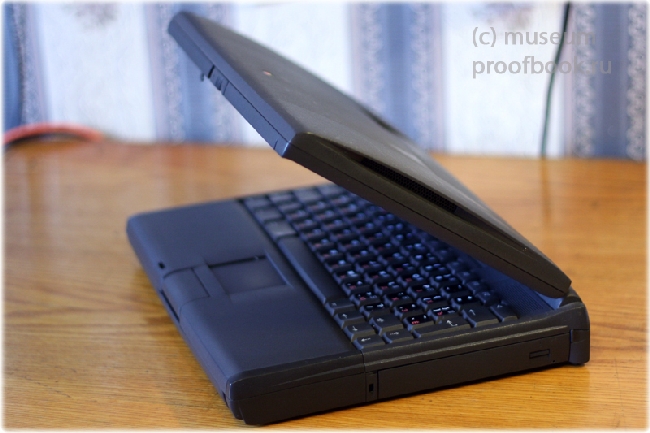
Instead of a cd-drive, you can install a floppy drive for 3.5 "floppy disks. To do this, unlock the lock and pull out the drive at the bottom of the laptop. The floppy drive is installed instead of the cd-drive.

On the back side are the IrDA window, a group of ports covered with a lid and a power connector.
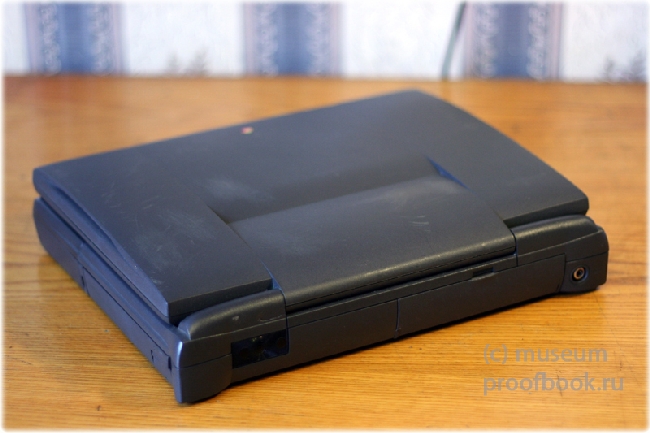
Under the cover you can find: network card connector, reset button, printer (or external modem) port, Scsi-connector, and VGA output to an external monitor. This powerbook supports monitors up to 20 "with resolutions from 512 x 384 to 1024 x 768 pixels.

For convenient operation, the laptop is equipped with retractable legs, which allow the keyboard to be placed at a slight angle and reduce the workload. On each side are located almost imperceptible buttons, by pressing which the legs move forward.

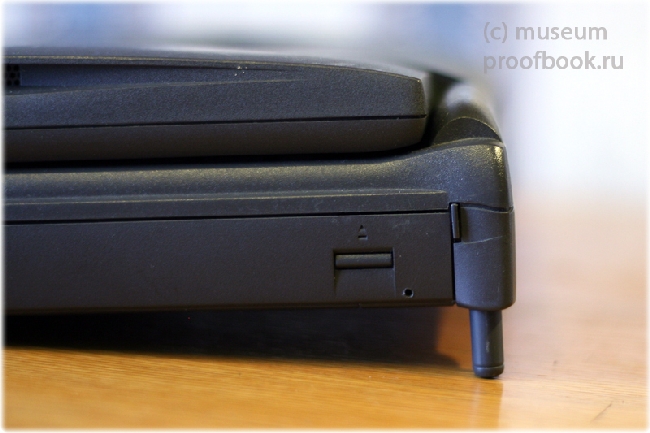
By pressing a button on the front panel, you can remove the battery.
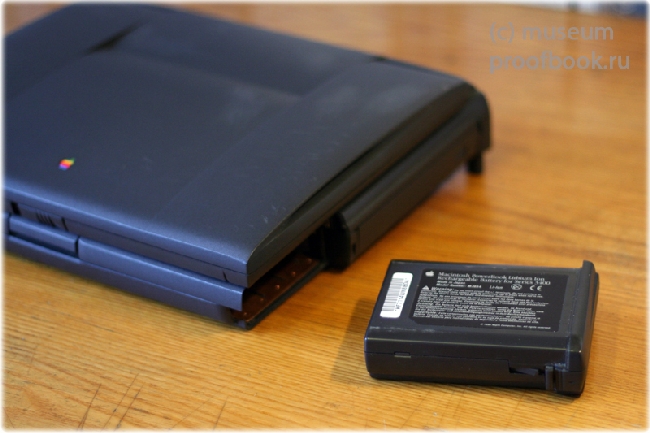
The most interesting thing: on the battery, in the seam, a button is hidden, by clicking on which you can find out the current state of charge.
Considering that the laptop is over 12 years old, the lithium-ion battery is surprising in its performance - up to one and a half hours you can work on a laptop without a power supply. A new battery should hold up to 4 hours.
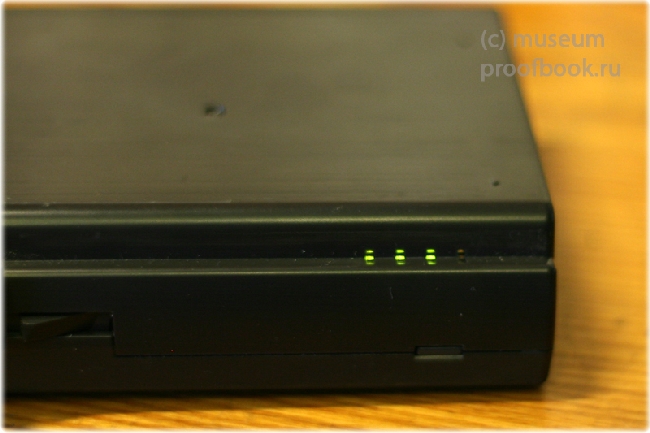
Well, finally, let's see an open laptop.
Above the keyboard are two rocker - adjust the sound level and adjust the brightness of the display.
The keyboard doesn’t particularly stand out, well, except for the location of the navigation keys (arrows), although other versions of powerbooks have an even more wonderful arrangement of these keys (in a row). The touchpad is of a small size, of course, even without a multitouch, but it is quite comfortable and frisky in reaction, and a touchpad key that is mega-friendly and pleasant to press.
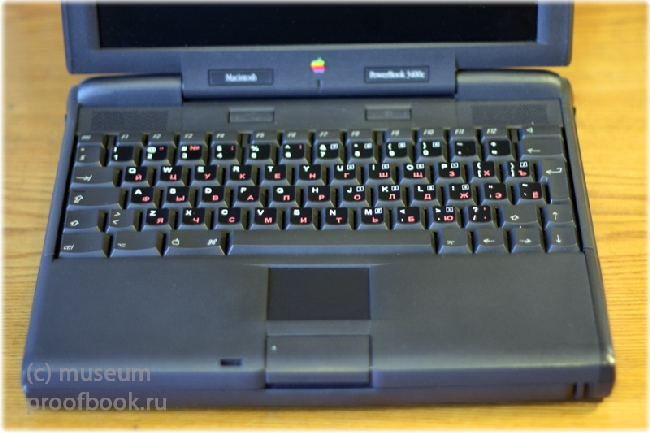
At first glance, it is not easy to find the power key, since it is located directly on the keyboard, above the backspace key with the image of a triangle.
The laptop is equipped with a microphone located under the rainbow logo.

Now look inside this beautiful exhibit.
Unscrewing a pair of screws, raise the keyboard.
Under the keyboard immediately noticeable green card RAM.
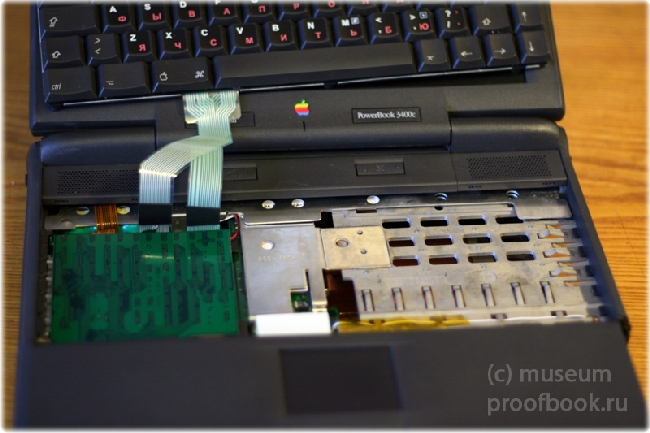
Not quite the usual format for RAM, but this is 97, many manufacturers have their own designs and formats. This notebook is equipped with a 64 MB memory card (another 16 are soldered on the motherboard), as seen in the photo, not all the chips are soldered. Maximum laptop supports 128 + 16 megabytes of memory.
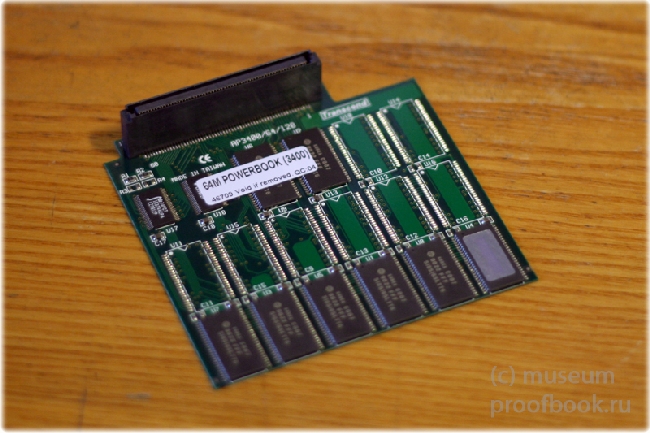
A little more twisting the screws and snapping off the latches, remove the upper part with the touchpad.
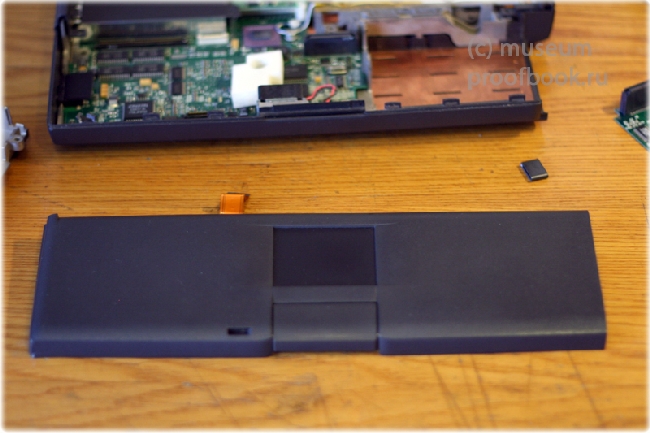
Hard disk mounted on the base part of the case.

The most common hard disk (2.5 "ide), except perhaps 3 mm thicker than modern :)

Also remove the battery charge module
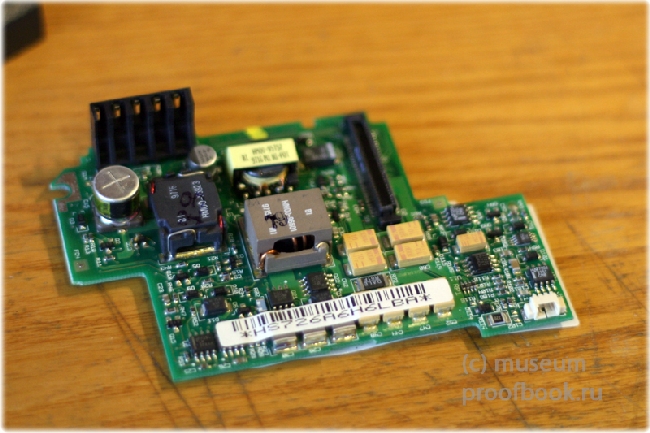
And after we unscrew the radiator, we can see the processor
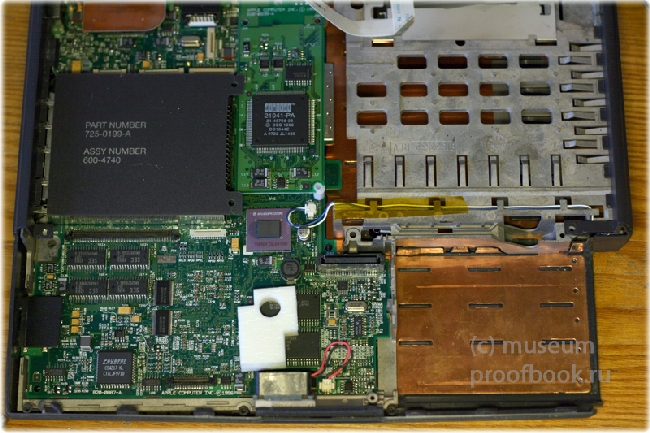


Looking around at the network card, I noticed a chip with a familiar digital label. I wouldn’t have turned on this inscription if a new laptop of this company ( digital HiNote VP ) had not recently appeared in my collection, about which I will write an interesting copy on a mobile tillamook processor soon.

Slightly forgot to show the power supply. It is also beautiful, also with a rainbow apple, with functional folding ears for winding the wire.
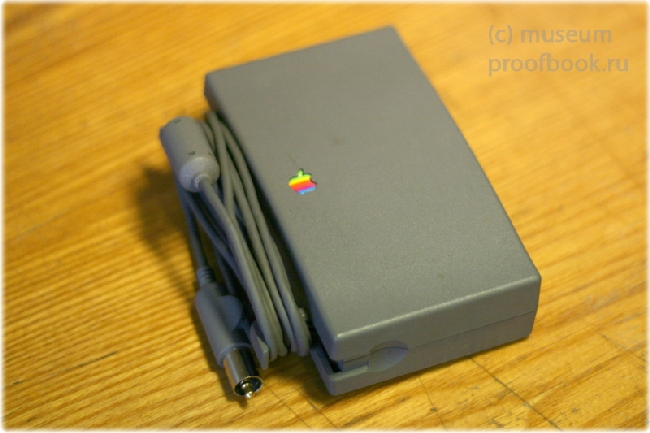
Well, disassembled, assembled, now we’ll look into the program part a little.
Classic Mac Os 9.1:
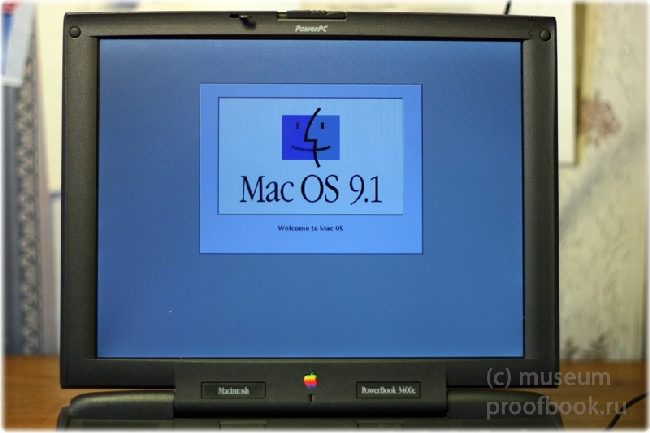
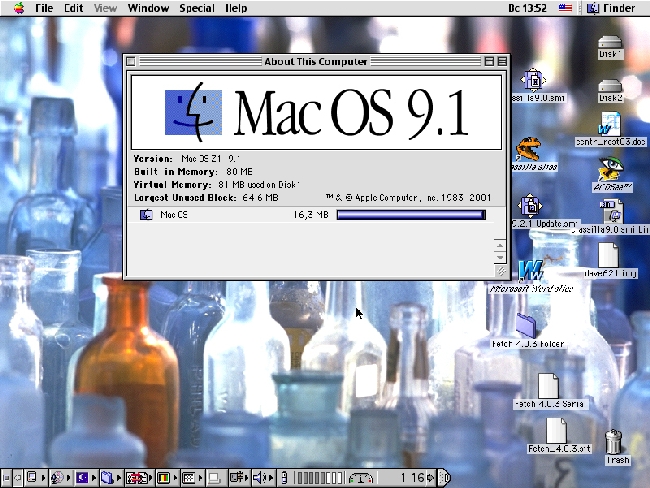
You can talk for a long time, what works you can perform on these technical specifications and what you can not; I am not so old and avid makovod (I hope “bye”). For example, you can try to surf the Internet, of course, you will not get much pleasure, but there is an opportunity :).
Having connected a network cable, I came on habr with the help of the Classilla browser.
After fighting with the captcha I got the following:

Obviously, the browser does not understand something modern;), typing habrahabr.ru again, I got to Habr (one could, of course, write that this post was prepared on this exhibit, but it was not good to lie :) macbook white helped me)
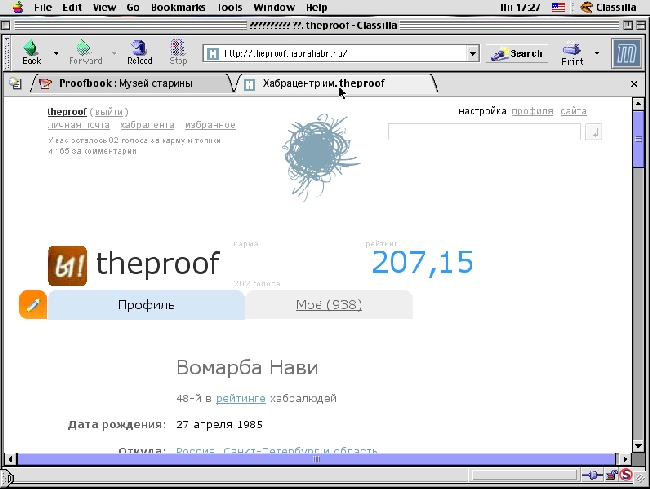
As the end of the story, I want to draw attention to the fact that in addition to the sound-reproducing speakers above the keyboard, the powerbook is equipped with another pair in the display lid (you can see the grilles at the ends of the lid). I could not resist and disassembled the cover :). Here it is - a solid design, a pair of speakers and a matrix.
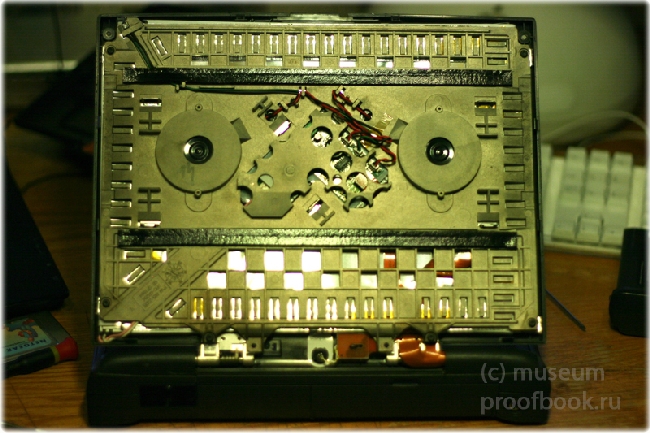
Here is such an interesting applebook.
upd: made screenshots from Habr clickable so that you can see better. :)

')
It was the first powerbook based on the Intel PCI architecture. This series of laptops was equipped with an active matrix.
In our museum was the average model line.

It is equipped with a 200 MHz PowerPC 603e processor, a 12.1 ″ display with a resolution of 800 × 600 pixels, 80 megabytes of RAM and a 2 GB 2.5 ”hard disk with an ide interface.

Consider it from all sides.
On the left are the audio connectors (microphone and headphones), two pcmcia slots, ADB-connector.
It should be immediately noted one feature: the extraction of pcmcia-cards is a little non-standard way. After pressing the button to the left of the corresponding slot, the mechanism “spits out” the card (the mechanical method is more usual, using pressure on the lever). In the off state or in sleep mode, pcmcia cards cannot be removed. For emergency cases, there is a hole next to each port, using a unfolded clip you can remove the card (just like in cd-drives).

Right: battery and cd drive. Between them there is a place for mounting the kensington system lock, above which the indicator light.

Instead of a cd-drive, you can install a floppy drive for 3.5 "floppy disks. To do this, unlock the lock and pull out the drive at the bottom of the laptop. The floppy drive is installed instead of the cd-drive.

On the back side are the IrDA window, a group of ports covered with a lid and a power connector.

Under the cover you can find: network card connector, reset button, printer (or external modem) port, Scsi-connector, and VGA output to an external monitor. This powerbook supports monitors up to 20 "with resolutions from 512 x 384 to 1024 x 768 pixels.

For convenient operation, the laptop is equipped with retractable legs, which allow the keyboard to be placed at a slight angle and reduce the workload. On each side are located almost imperceptible buttons, by pressing which the legs move forward.


By pressing a button on the front panel, you can remove the battery.

The most interesting thing: on the battery, in the seam, a button is hidden, by clicking on which you can find out the current state of charge.
Considering that the laptop is over 12 years old, the lithium-ion battery is surprising in its performance - up to one and a half hours you can work on a laptop without a power supply. A new battery should hold up to 4 hours.

Well, finally, let's see an open laptop.
Above the keyboard are two rocker - adjust the sound level and adjust the brightness of the display.
The keyboard doesn’t particularly stand out, well, except for the location of the navigation keys (arrows), although other versions of powerbooks have an even more wonderful arrangement of these keys (in a row). The touchpad is of a small size, of course, even without a multitouch, but it is quite comfortable and frisky in reaction, and a touchpad key that is mega-friendly and pleasant to press.

At first glance, it is not easy to find the power key, since it is located directly on the keyboard, above the backspace key with the image of a triangle.
The laptop is equipped with a microphone located under the rainbow logo.

Now look inside this beautiful exhibit.
Unscrewing a pair of screws, raise the keyboard.
Under the keyboard immediately noticeable green card RAM.

Not quite the usual format for RAM, but this is 97, many manufacturers have their own designs and formats. This notebook is equipped with a 64 MB memory card (another 16 are soldered on the motherboard), as seen in the photo, not all the chips are soldered. Maximum laptop supports 128 + 16 megabytes of memory.

A little more twisting the screws and snapping off the latches, remove the upper part with the touchpad.

Hard disk mounted on the base part of the case.

The most common hard disk (2.5 "ide), except perhaps 3 mm thicker than modern :)

Also remove the battery charge module

And after we unscrew the radiator, we can see the processor



Looking around at the network card, I noticed a chip with a familiar digital label. I wouldn’t have turned on this inscription if a new laptop of this company ( digital HiNote VP ) had not recently appeared in my collection, about which I will write an interesting copy on a mobile tillamook processor soon.

Slightly forgot to show the power supply. It is also beautiful, also with a rainbow apple, with functional folding ears for winding the wire.

Well, disassembled, assembled, now we’ll look into the program part a little.
Classic Mac Os 9.1:


You can talk for a long time, what works you can perform on these technical specifications and what you can not; I am not so old and avid makovod (I hope “bye”). For example, you can try to surf the Internet, of course, you will not get much pleasure, but there is an opportunity :).
Having connected a network cable, I came on habr with the help of the Classilla browser.
After fighting with the captcha I got the following:

Obviously, the browser does not understand something modern;), typing habrahabr.ru again, I got to Habr (one could, of course, write that this post was prepared on this exhibit, but it was not good to lie :) macbook white helped me)

As the end of the story, I want to draw attention to the fact that in addition to the sound-reproducing speakers above the keyboard, the powerbook is equipped with another pair in the display lid (you can see the grilles at the ends of the lid). I could not resist and disassembled the cover :). Here it is - a solid design, a pair of speakers and a matrix.

Here is such an interesting applebook.
upd: made screenshots from Habr clickable so that you can see better. :)
Source: https://habr.com/ru/post/71590/
All Articles